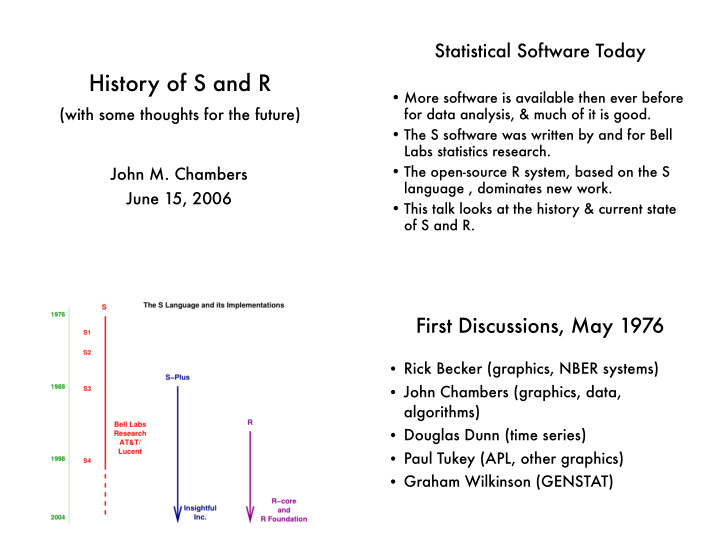



Statistical Software Today History of S and R • More software is available then ever before (with some thoughts for the future) for data analysis, & much of it is good. • The S software was written by and for Bell Labs statistics research. • The open-source R system, based on the S John M. Chambers language , dominates new work. June 15, 2006 • This talk looks at the history & current state of S and R. First Discussions, May 1976 • Rick Becker (graphics, NBER systems) • John Chambers (graphics, data, algorithms) • Douglas Dunn (time series) • Paul Tukey (APL, other graphics) • Graham Wilkinson (GENSTAT)
May 5, 1976 S Version 1 (1976-1978) Sketch proposing an interface between S functions and • Implementation nearly all Fortran based, Fortran routines. via preprocessing tools. And (below) the • Only for our (bizarre) operating system. structure of function arguments and • Adopted our existing graphics & data values as lists of structure software. named elements. • Interfaces to many algorithms (random numbers, linear algebra, some models). 5 Meanwhile, Unix & Licensing S Version 2 • Unix developed roughly in parallel to us, • Portability via a Unix implementation: also in a local form. – Unix ports most features for us – Device-independent graphics • Portable Unix designed ~1978 (32 bit!). – Model for machine numerical properties • We decided to port S to Unix. • Most features carried over from V. 1. • AT&T adopted a licensing policy (very • Licensed to the outside from ~1981; cheap for universities). books in 1984/5. • S rode along with Unix & a few others.
S Version 3 (1983-1992) (the `blue book’) • Merged some new ideas with S. • “Everything is an object” (including functions). • Functional evaluation model. • .C(), .Fortran(), no Interface Language. • No direct back compatibility with S2. Statistical Models in S (S3) (the `white book’) • An object-based approach. • Model formulas (& terms objects). • Data Frames (& model frames, …). • S3 methods – Give the user a simple call for plot, summary, predict, etc. – Minimal additions to S engine & API
S Version 4 (1995-1998) Events from 1995 to present (the `green book’) • `Computing with data’ distinguished from • S Version 4 statistical computing. • S software licensed exclusively (1993), • Extensions to the S programming model: eventually sold to Insightful (2004). • ACM `Software System’ award – Classes and methods with metadata – Connections, documentation objects, … • Along came • Today we have the S language , implemented in R and S-Plus software . --A real success story What & Who is R? • Ross Ihaka & Robert Gentleman wrote an • Software for statistics, data management, experimental R, “not unlike S” (ca 1995). programming, etc. exists in quantity & • R-core (17 people), R Foundation (5 variety unimaginable 15 years ago. directors) control the design & evolution. • Quality varies, but on average is impressive. • Contributors from many countries, mostly • And, most of this is in an open environment academics, provide packages & tools. that encourages improvements. • Users; number unknown: ~100K? Important • Wide participation from the statistics concentration among students, researchers. profession is also a healthy sign.
The Future Can R Meet the Challenges? Challenges for statistical software: The responses require new software that • Data processes in real-time does more than just add to current R • Embed our software in their software and its packages. The computing • Very large scale applications research needed is risky: to use the Will an open-source system like R results will require basic changes. respond to these challenges? Where are the resources and the organization to take such steps? Will Fundamental Change Statistical Software Today Be Possible? • • Who would have imagined it all, in 1976? At two major change points (S3 and start of R), researchers had freedom and support for change. • Current software is good for statistics, and • Future changes will have to face the popularity of gratifying for the originators of S. current R (resistance to breaking anything). • But the resources of 1976 are not available • Researchers at the level of expertise needed are now, as we look to meet new challenges. scattered , and scarce. • Let’s hope that new people and new • Needed: support for risky, fundamental change, resources will take up the challenges. and a plan to use the results.
Recommend
More recommend